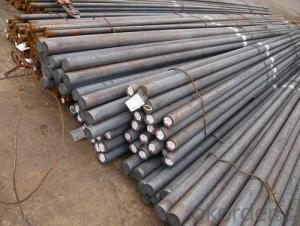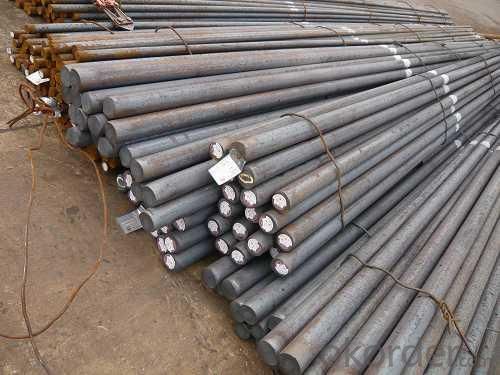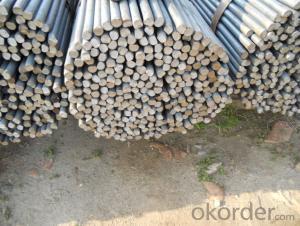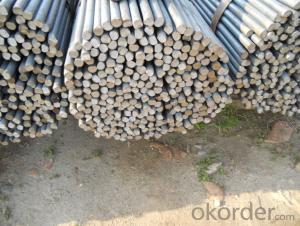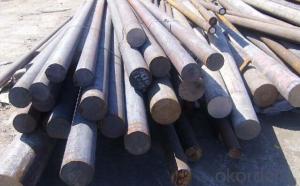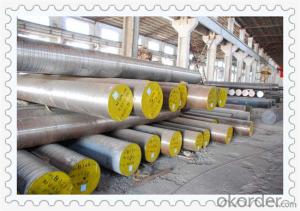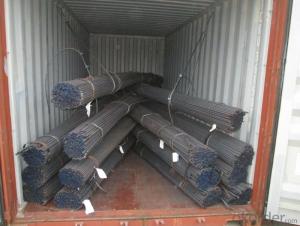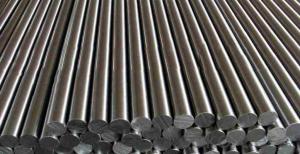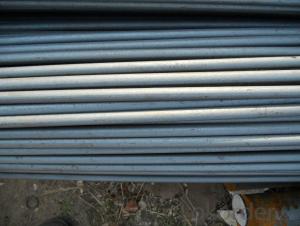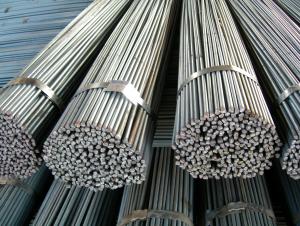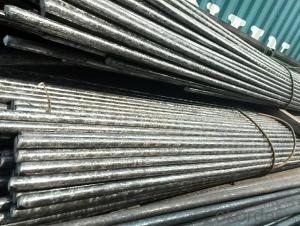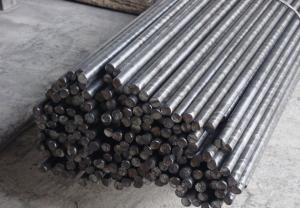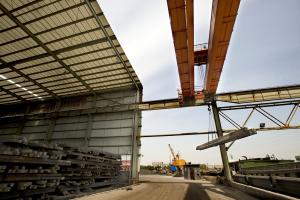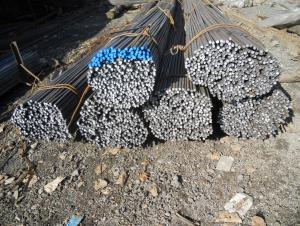Hot Rolled Iron Steel Round Bars in High Quality
- Loading Port:
- Tianjin
- Payment Terms:
- TT or LC
- Min Order Qty:
- 100 m.t.
- Supply Capability:
- 40000 m.t./month
OKorder Service Pledge
OKorder Financial Service
You Might Also Like
OKorder is offering Hot Rolled Iron Steel Round Bars in High Quality at great prices with worldwide shipping. Our supplier is a world-class manufacturer of steel, with our products utilized the world over. OKorder annually supplies products to African, South American and Asian markets. We provide quotations within 24 hours of receiving an inquiry and guarantee competitive prices.
Product Applications:
Hot Rolled Iron Steel Round Bars in High Quality are ideal for structural applications and are widely used in the construction of buildings and bridges, and the manufacturing, petrochemical, and transportation industries.
Product Advantages:
OKorder's Hot Rolled Iron Steel Round Bars in High Quality are durable, strong, and wide variety of sizes.
Main Product Features:
· Premium quality
· Prompt delivery & seaworthy packing (30 days after receiving deposit)
· Can be recycled and reused
· Mill test certification
· Professional Service
· Competitive pricing
Product Specifications:
Manufacture: Hot rolled
Grade: Q195 – 235
Certificates: ISO, SGS, BV, CIQ
Length: 6m – 12m, as per customer request
Packaging: Export packing, nude packing, bundled
Trademark | Rank | Chemical composition (quality score) % | |||||
C | Si | Mn | S | P | |||
≤ | ≤ | ≤ | |||||
Q235 | A | 0.14-0.22 | 0.30 | 0.30-0.65 | 0.050 | 0.045 | |
Q235 | B | 0.12-0.20 | 0.30 | 0.30-0.70 | 0.045 | 0.045 | |
Trademark | Rank | Pulling Test | |||||
Bend PointΔs/Mpa | Tensile Strength | Elongation Ratioδ5% | |||||
Thickness (Diameter) /MM | Thickness (Diameter) /MM | ||||||
≤16 | 16-40 | ≤16 | 16-40 | ||||
≥ | ≥ | ||||||
Q235 | A | 235 | 225 | 375-500 | 26 | 25 | |
Q235 | B | 235 | 225 | 375-500 | 26 | 25 | |
FAQ:
Q1: Why buy Materials & Equipment from OKorder.com?
A1: All products offered byOKorder.com are carefully selected from China's most reliable manufacturing enterprises. Through its ISO certifications, OKorder.com adheres to the highest standards and a commitment to supply chain safety and customer satisfaction.
Q2: How do we guarantee the quality of our products?
A2: We have established an advanced quality management system which conducts strict quality tests at every step, from raw materials to the final product. At the same time, we provide extensive follow-up service assurances as required.
Q3: How soon can we receive the product after purchase?
A3: Within three days of placing an order, we will arrange production. The normal sizes with the normal grade can be produced within one month. The specific shipping date is dependent upon international and government factors, the delivery to international main port about 45-60days.
Q4: How many tons of steel products could be loaded in containers?
A4: Usually the steel products are delivered by bulk vessel because of the large quantity and the freight. However, there are no bulk vessel enter some seaports so that we have to deliver the cargo by containers. The 6m steel product can be loaded in 20FT container, but the quantity is changed according to the size, usually from 18tons to 25tons.
Q5: what is the difference between actual weight and theoretical weight?
A5: All the section steel has two weights: actual weight and theoretical weight. Actual weight is the weighing out when the product delivered from the mill. Theoretical weight is calculated by pieces. The invoice can be based on each of them as your request.
Images:
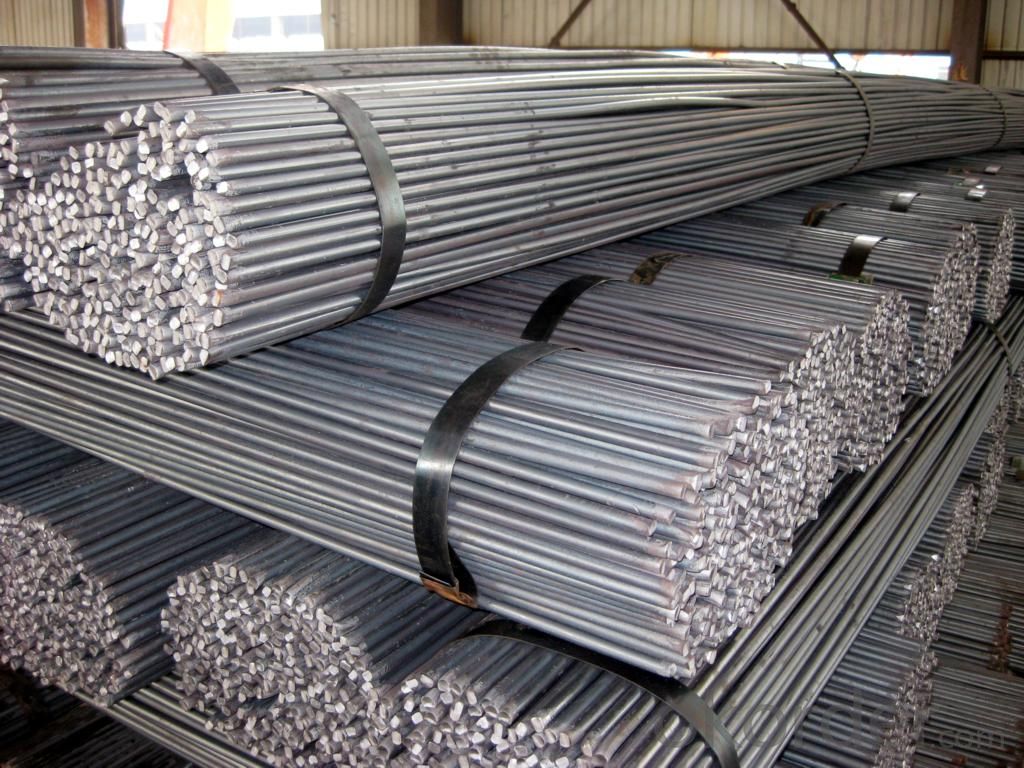
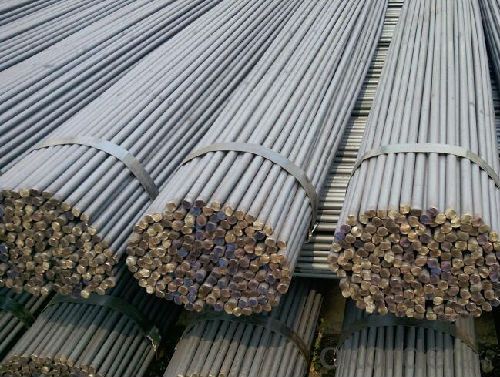
- Q: What kind of nuts do you need for round 20 rounds?
- The M22 thread can be made, if made M20, need a car off some. You may be talking about support, depending on how big your lead screw is.Stainless steel round bar refers to the solid steel strip with round section. The specifications are expressed in millimeters of diameter, such as "50", which means a stainless steel round bar of 50 millimeters in diameter.
- Q: Can steel round bars be used in the hospitality industry?
- Yes, steel round bars can be used in the hospitality industry. Steel round bars are versatile and durable, making them suitable for various applications within the industry. They can be used for constructing furniture, such as chairs, tables, and bar stools, as well as for creating decorative elements like railings, light fixtures, and signage. Steel round bars also provide excellent strength and stability, ensuring the safety of guests and staff. Moreover, they can be easily customized to match the desired aesthetic and design preferences of different hospitality establishments. Overall, steel round bars are a reliable and practical choice for the hospitality industry due to their durability, versatility, and aesthetic appeal.
- Q: Are steel round bars suitable for the production of fasteners?
- Yes, steel round bars are suitable for the production of fasteners. Steel is a strong and durable material that can withstand high levels of tension and pressure, making it ideal for fasteners. Round bars, in particular, offer a smooth and uniform surface that is easy to machine and shape into various types of fasteners such as bolts, screws, and studs. The versatility of steel round bars allows for customization in terms of size, length, and surface finish, making them suitable for a wide range of fastening applications in industries such as construction, automotive, and manufacturing. Additionally, steel round bars have excellent corrosion resistance properties when coated with protective finishes, ensuring the longevity and reliability of the fasteners.
- Q: What are the advantages of using structural steel round bars?
- There are several advantages of using structural steel round bars in various applications. Firstly, structural steel round bars offer exceptional strength and durability. The circular shape of the bar allows for even distribution of weight and stress, making it highly resistant to bending and breaking. This strength is particularly beneficial in applications where the bars are subjected to heavy loads or extreme weather conditions. Additionally, structural steel round bars are highly versatile. They can be easily shaped and manipulated to fit specific project requirements, allowing for greater design flexibility. This versatility makes them suitable for a wide range of applications, including construction, manufacturing, and engineering projects. Another advantage of using structural steel round bars is their cost-effectiveness. Steel is a relatively affordable material, and the efficiency of the manufacturing process makes it a cost-effective choice for various projects. Furthermore, the durability and longevity of steel round bars reduce the need for frequent maintenance or replacement, resulting in long-term cost savings. Furthermore, structural steel round bars offer excellent resistance to corrosion. Steel is inherently resistant to rust and other forms of corrosion, making it highly suitable for outdoor or high-moisture environments. This resistance extends the lifespan of the bars and ensures their structural integrity over time. Lastly, structural steel round bars are readily available and easily sourced. Steel is a widely used material, and it is produced in large quantities, making it readily available in various sizes and grades. This accessibility ensures that steel round bars can be easily obtained, reducing project delays and increasing overall efficiency. In conclusion, the advantages of using structural steel round bars include exceptional strength and durability, versatility, cost-effectiveness, resistance to corrosion, and easy availability. These benefits make structural steel round bars a preferred choice for a wide range of applications, providing a reliable and efficient solution for various construction and engineering projects.
- Q: Q235 and mechanical properties of hot rolled steel cold drawn steel have what difference, Q235 hot rolled steel with 12 combined shearing machine has a number of very hard, the damage of the blades, why
- Secondly, have a great relationship with the mechanical properties of heat treatment of steel, quenching hardness increased, annealing hardness decreases, the same kind of material of steel under different heat treatment, the hardness difference is very big, you said the hot bar is excellent, there may have been a quenching in the production process
- Q: What is the difference between a hot-rolled and a cold-drawn steel round bar?
- The main difference between a hot-rolled and a cold-drawn steel round bar lies in the manufacturing process. Hot-rolled steel round bars are formed by heating and rolling the steel at high temperatures, resulting in a rougher surface finish and less precise dimensions. On the other hand, cold-drawn steel round bars are formed by pulling the steel through a die at room temperature, resulting in a smoother surface finish and more precise dimensions. Cold-drawn steel round bars also tend to have improved mechanical properties and a higher strength-to-weight ratio compared to hot-rolled steel round bars.
- Q: What are the factors to consider when selecting a steel round bar for a specific application?
- When choosing a steel round bar for a particular application, there are several key factors that need to be taken into account. Firstly, the material grade of the steel round bar is of utmost importance. Different grades of steel have different properties, such as strength, hardness, and resistance to corrosion. It is crucial to select a material grade that is suitable for the specific requirements of the application. Secondly, the mechanical properties of the steel round bar, such as tensile strength, yield strength, and elongation, need to be carefully evaluated. These properties determine how well the bar can withstand forces and deformations under load. It is important to choose a steel round bar with mechanical properties that are compatible with the demands of the application. The size and dimensions of the steel round bar also play a critical role. This includes considering the diameter, length, and tolerance requirements. The dimensions should be chosen based on the structural needs of the application and the desired load-bearing capacity of the bar. The surface finish of the steel round bar is significant, particularly in applications where aesthetics or contact with other components are important. Factors such as smoothness, roughness, and the presence of coatings or treatments should be taken into account. Depending on the environment in which the application will be used, it is crucial to select a steel round bar with adequate corrosion resistance. Factors such as exposure to moisture, chemicals, or extreme temperatures can impact the bar's performance and longevity. Options like stainless steel or corrosion-resistant coatings can be considered to enhance the bar's resistance to corrosion. If the steel round bar needs to be machined or fabricated into a specific shape, its machinability must be considered. Some steel grades are easier to machine than others and may require different tools or techniques. It is important to choose a bar with a machinability that aligns with the desired manufacturing processes. Lastly, the cost of the steel round bar should not be overlooked. Different material grades and specifications come with varying price points. It is important to strike a balance between the required properties and performance of the bar and the budget constraints of the project. In conclusion, selecting a steel round bar for a specific application necessitates careful consideration of the material grade, mechanical properties, size, surface finish, corrosion resistance, machinability, and cost. By taking these factors into account, one can ensure that the chosen steel round bar will meet the requirements of the application and deliver optimal performance.
- Q: Can steel round bars be used for making cutlery or kitchen utensils?
- No, steel round bars are not typically used for making cutlery or kitchen utensils. These items are usually made from stainless steel or other food-safe materials that are specifically designed for food contact and are more suitable for the purpose.
- Q: Can steel round bars be used in high-temperature environments?
- Indeed, steel round bars are capable of being utilized in environments with high temperatures. Steel is renowned for its exceptional strength and durability, rendering it suitable for a diverse range of applications that involve exposure to elevated temperatures. However, it is crucial to consider the specific grade of steel employed since various grades possess distinct temperature limits. Certain steel alloys, such as stainless steel, exhibit exceptional resistance against corrosion and oxidation under high temperatures, making them particularly ideal for deployment in environments characterized by elevated heat. Moreover, heat treatments can also be administered to steel to augment its performance in conditions with high temperatures. In summary, the selection of the appropriate grade and application of treatments to steel round bars can ensure their aptness and efficacy in high-temperature environments.
- Q: What kind of steel pipe is round steel?
- A round bar is not a steel tube. In brief, its section is round, but it is solid, and the cross section of the pipe is hollow.
Send your message to us
Hot Rolled Iron Steel Round Bars in High Quality
- Loading Port:
- Tianjin
- Payment Terms:
- TT or LC
- Min Order Qty:
- 100 m.t.
- Supply Capability:
- 40000 m.t./month
OKorder Service Pledge
OKorder Financial Service
Similar products
Hot products
Hot Searches
Related keywords
